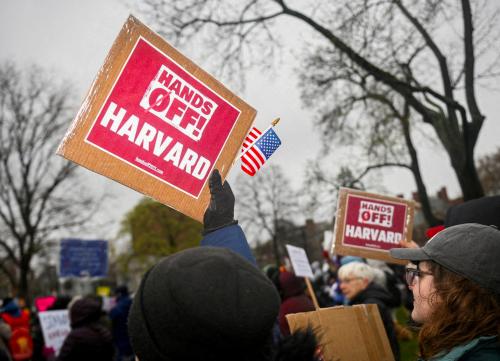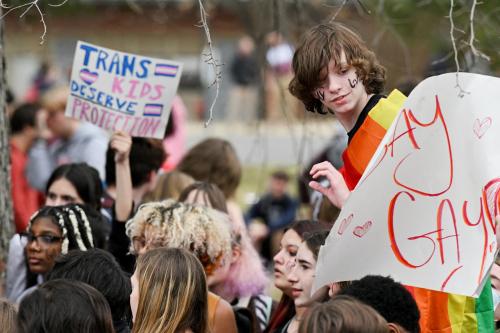On June 29, 2023, the Supreme Court ruled in Students for Fair Admissions, Inc. (SFFA) v. University of North Carolina and SFFA v. President & Fellows of Harvard College that the colleges’ use of race as a decision factor in college admissions is a violation of the Equal Protection Clause of the 14th Amendment. The decision rejected prior justifications of race-conscious admissions based on universities’ interest in building racially diverse student populations and will have an immediate impact on admissions practices at selective institutions across the country.
Going forward, states and universities that hope to achieve the same racial diversity as they have under race-based affirmative action will need to pursue alternate policies to reach those goals. To what extent are there viable alternative policies to achieve those goals, and what is the likely effectiveness of those policies across states?
What are the legal arguments for affirmative action?
There have been two main legal arguments for the consideration of race in admissions. The first argument is that diversity benefits students and society. This “compelling interest in diversity” has been the central legal justification for continuing race-conscious admissions in prior affirmative action cases. Research consistently supports this argument. For example, students who enroll in more diverse college classrooms earn high GPAs, more diverse college discussion groups generate more novel and complex analyses, and across college settings, greater exposure to diverse thoughts and peers increases civic attitudes and engagement. Further, there are many benefits to a diverse workforce – such as a diverse military force, medical corps, or teaching profession. Expanding diversity in undergraduate programs is an essential step to building a workforce pipeline to achieve those benefits. However, in the majority opinion in SFFA, Chief Justice John Roberts was critical of how colleges set goals for diversity, arguing that the current implementation of race-conscious admissions fails to meet judicial strict scrutiny standards – namely that the diversity goals institutions set are vague, impossible to measure, and negatively affect some racial groups at the expense of others.
The second argument colleges (and amici in the two cases this term) make for the use of affirmative action is reparative. This perspective argues that race-conscious admission seeks to remedy persistent racial discrimination and ongoing racial inequities in society. Such inequities are rampant in K-12 education. While this may be the motivating goal for many colleges, the majority opinion in Regents of the University of California v. Bakke (in 1978) advanced the compelling interest in diversity justification over the social justice rationale as the primary legal justification for race-conscious admissions. While dissents from Justice Sonia Sotomayor and Justice Ketanji Brown Jackson both advanced the argument that race-conscious admissions serves to remedy past discrimination, Chief Justice Roberts’ majority opinion argued that the Court has “long rejected” this legal justification, and that neither UNC nor Harvard advanced that argument in their defense of their admissions policies.
What will happen if colleges can’t consider race in admissions?
In the majority opinion in Grutter v. Bollinger, former Justice Sandra Day O’Connor noted that the Court expected “racial preferences will no longer be necessary” within 25 years of their decision and that “race-conscious admissions policies must be limited in time.” Indeed, that timeline factored significantly into oral arguments in the SFFA cases and in Chief Justice Roberts’ majority opinion. Enrollment trends do not indicate colleges are significantly more representative than they were in the early 2000s. A report from the Georgetown Center on Education and the Workforce found that white and Asian students are more overrepresented at selective institutions, and Black, Hispanic, and Native students are more underrepresented, in 2020 than they were in the early 2000s. While enrollment of underrepresented minority (URM) students has increased over time, it has done so at a slower pace than broader demographic changes, and the share of URM students at selective universities is about half the share of URM students in the most recent 12th grade cohort.
Several states have banned race-conscious admissions, providing insights into what may happen following a national ban. Statewide URM enrollment slightly decreases following a ban on race-conscious admissions, and declines are larger at more selective institutions. One study found state bans reduced Black enrollment at top-50 public colleges by about one-third – from about 6% to 4%. One model estimates a national ban will result in a 2% reduction in URM representation at all four-year colleges and up to a 10% reduction in URM representation at the most selective four-year schools.
The effects of state bans on racial gaps in college admission and enrollment have persisted and slightly worsened over time at state flagship colleges. Beyond undergraduate admission, states that banned affirmative action experienced a 17% decline in URM medical school enrollment and a 12% reduction in URM graduate school enrollment. California’s ban on affirmative action shifted URM students to lower-quality undergraduate programs, reduced URM STEM graduation rates, and ultimately reduced URM students’ early career incomes by about 5% (with the largest declines for Hispanic students).
Achieving racial diversity without considering race
How should colleges rethink college admissions in the wake of the Supreme Court’s decisions? The White House has already released guidance to assist colleges with interpreting the decision and alternative policies to pursue. However, several theoretically compelling strategies will not fully overcome the anticipated drop in URM student enrollment following an affirmative action ban.
One way to admit students to highly selective colleges would be to randomly select a group of students from among a pool who meet a minimum GPA or test score. However, research finds that approach would result in substantially smaller shares of Black and Hispanic students than currently enrolled at selective colleges.
Others have suggested socioeconomic-based affirmative action as an alternative, and Justice Neil Gorsuch’s SFFA concurrence advanced this alternative as well. To be sure, Black families’ wealth is substantially lower than white families, so it is possible that a higher share of Black applicants might benefit from wealth-based affirmative action than the share of white applicants. But simulations find that wealth-based affirmative action would not achieve the same levels of racial diversity as race-conscious affirmative action, in part because the number of lower-income Black applicants is still smaller than the number of white lower-income applicants. As former Justice Harry Blackmun wrote in his concurrence in Regents of the University of California v. Bakke, “to get beyond racism, we must first take account of race.” Further, many colleges currently tout being “need-blind” in their admissions review. In addition to encouraging more low-income students to apply, being “need blind” provides some colleges an exemption from the application of certain anti-trust laws when it comes to determining financial aid awards. Engaging in socioeconomic-based affirmative action may constitute being classified as “need aware” – potentially threatening eligibility for those exemptions.
In the wake of affirmative action bans, several states turned to top X% plans – offering guaranteed admission to a certain share of students from each high school. Studies suggest that while these approaches do increase URM enrollment, the effect is smaller than race-conscious admissions. In California, the top 4% plan increased URM enrollment in the UC system by 4%, compared to a 20% increase in URM enrollment when colleges use race-based affirmative action.
Colleges can also engage in expanded outreach to students, encouraging applications and providing students with assistance navigating the complex college application and financial aid processes. One version of expanded outreach is expanding the number and types of high schools and regions admissions officers visit during recruiting season, though this requires additional staff time. Other approaches have tried sending “pre-guarantees” to students – for example, sending students notices they’re eligible for free tuition at the state flagship, or piloting direct admission offers to students based on their test scores or high school transcripts. The University of California system engaged in extensive outreach following the state ban on race-conscious admissions but argued in an amicus brief in the Harvard and UNC cases that those efforts have been insufficient to achieve their diversity goals.
Eliminate practices that advantage the most advantaged
In addition to proactive efforts to recruit, admit, and enroll minoritized students, college should also eliminate admission practices that give an advantage to the most advantaged applicants.
First, end legacy preferences. Legacy admissions – giving an edge to students whose family members attended the college – give a boost to those who should need it the least. About the same share of the public opposes considering relative ties in college admissions (75%) as those who oppose considering race or ethnicity (74%) – with Republicans and Democrats opposing legacy considerations at about the same rate. This has always been a dubious policy, and now is the time for colleges to abandon the practice.
Second, inventory the use of early decision and early action application rounds. Early admission applicants are at least 25% more likely to gain admission at highly selective institutions under early decision. Early decision requires students to commit to a college prior to receiving a financial aid award (making is less appealing for lower- or middle-income applicants) and benefits students who can prepare application materials earlier in the year (likely because they have family and mentors who support application preparation). Early admissions applicants are about three times as likely to attend a private high school, and while 21% of Asian and 10% of white applicants applied early admissions somewhere, only 8% of Latino and 7% of Black students did so.
These practices will not alone overcome the anticipated drop in Black, Hispanic, and Native college enrollment in the wake of a national ban on race-conscious admissions but serve as a feasible first step. It is also important to note adjustments to admissions review criteria are not enough to affect enrollment. One analysis found that providing admissions officers with more information about students’ backgrounds increased the likelihood students from more challenging high school contexts (e.g., higher crime, less housing stability) were admitted. But the tool did not increase those students’ enrollment on average – and the colleges where it did were those that used the contextual information to better target scholarship aid. Colleges must back up admissions officers with financial aid and student services to ensure all students feel welcome and supported on campus. This is a particularly challenging task given the swath of bills from Republican legislatures targeting spending on the very diversity, equity, and inclusion programs that help students feel connected to campus.
A new precedent for college admissions
While the SFFA decision is a significant blow to colleges and universities that have long relied on race-conscious admissions to achieve institutional diversity goals, the decision doesn’t completely shut the door on revised approaches to admissions. For example, the Chief Justice included a key footnote that military academies are exempt from the decision, given their “distinct interests” – namely arguments that racial diversity in the military is essential to national security. This implies that there are compelling interests to diversity that would survive strict scrutiny review. The Court has set a high bar for when there is a compelling interest in considering race in admissions – but not removed the principle.
Further, the decision makes explicit that students can continue to reference their racial and ethnic identities in college essays and interviews and colleges can take those experiences into account in application review; however, the decision cautions such references and the role they play in admissions decisions must be tied to individual, non-racial characteristics. For example, colleges can give weight to a student’s “courage and determination” to overcome racial discrimination during holistic review. This is an important victory for those who worried that the decision would severely limit students’ ability to speak about how their racial identity shaped their experiences. However, that guidance will be difficult to implement in practice and is ripe for future legal challenges. While much remains to be understood about the SFFA decision and its impact, one clear takeaway is that this will not be the last word on how race can factor into college admissions.
-
Acknowledgements and disclosures
The author would like to acknowledge the research assistance of Brown Center spring 2023 intern Elizabeth Gellman.
The Brookings Institution is committed to quality, independence, and impact.
We are supported by a diverse array of funders. In line with our values and policies, each Brookings publication represents the sole views of its author(s).




Commentary
The end of race-conscious admissions
June 29, 2023